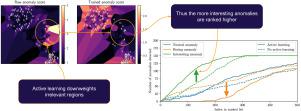Astronomy and Computing ( IF 1.9 ) Pub Date : 2021-06-09 , DOI: 10.1016/j.ascom.2021.100481 M. Lochner , B.A. Bassett

|
Survey telescopes such as the Vera C. Rubin Observatory and the Square Kilometre Array will discover billions of static and dynamic astronomical sources. Properly mined, these enormous datasets will likely be wellsprings of rare or unknown astrophysical phenomena. The challenge is that the datasets are so large that most data will never be seen by human eyes; currently the most robust instrument we have to detect relevant anomalies. Machine learning is a useful tool for anomaly detection in this regime. However, it struggles to distinguish between interesting anomalies and irrelevant data such as instrumental artefacts or rare astronomical sources that are simply not of interest to a particular scientist. Active learning combines the flexibility and intuition of the human brain with the raw processing power of machine learning. By strategically choosing specific objects for expert labelling, it minimises the amount of data that scientists have to look through while maximising potential scientific return. Here we introduce Astronomaly: a general anomaly detection framework with a novel active learning approach designed to provide personalised recommendations. Astronomaly can operate on most types of astronomical data, including images, light curves and spectra. We use the Galaxy Zoo dataset to demonstrate the effectiveness of Astronomaly, as well as simulated data to thoroughly test our new active learning approach. We find that for both datasets, Astronomaly roughly doubles the number of interesting anomalies found in the first 100 objects viewed by the user. Astronomaly is easily extendable to include new feature extraction techniques, anomaly detection algorithms and even different active learning approaches. The code is publicly available at https://github.com/MichelleLochner/astronomaly.
中文翻译:

Astronomaly:天文数据中的个性化主动异常检测
Vera C. Rubin 天文台和平方公里阵列等巡天望远镜将发现数十亿个静态和动态天文来源。如果挖掘得当,这些庞大的数据集很可能是罕见或未知的天体物理现象的源泉。挑战在于数据集如此之大,以至于大多数数据永远不会被人眼看到;目前我们拥有的最强大的工具来检测相关异常。机器学习是在这种情况下进行异常检测的有用工具。然而,它很难区分有趣的异常现象和不相关的数据,例如仪器人工制品或特定科学家根本不感兴趣的稀有天文来源。主动学习将人脑的灵活性和直觉与机器学习的原始处理能力相结合。通过战略性地选择特定对象进行专家标记,它最大限度地减少了科学家必须查看的数据量,同时最大限度地提高潜在的科学回报。这里我们介绍Astronomaly:一种通用的异常检测框架,采用新颖的主动学习方法,旨在提供个性化推荐。Astronomaly可以处理大多数类型的天文数据,包括图像、光变曲线和光谱。我们使用 Galaxy Zoo 数据集来证明Astronomaly的有效性,以及模拟数据来彻底测试我们新的主动学习方法。我们发现,对于这两个数据集,Astronomaly将用户查看的前 100 个对象中发现的有趣异常的数量大致翻了一番。天文异常很容易扩展到包括新的特征提取技术、异常检测算法甚至不同的主动学习方法。该代码可在 https://github.com/MichelleLochner/astronomaly 上公开获得。











































 京公网安备 11010802027423号
京公网安备 11010802027423号